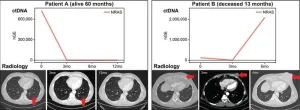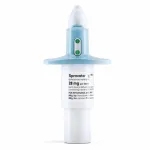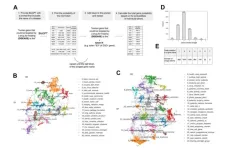(Press-News.org) Circulating tumor DNA (ctDNA) is emerging as a blood-based biomarker for many solid tumor types, including melanoma. A new study that assessed ctDNA in the blood of patients with BRAF wild-type (BRAF WT) stage III and IV melanoma concludes that measuring ctDNA may lead to alternative treatment options and better outcomes for these patients, report investigators in The Journal of Molecular Diagnostics, published by Elsevier.
For patients with BRAF WT stage III and IV melanoma, there is an urgent clinical need to identify prognostic biomarkers and biomarkers to predict treatment response. Approximately 40% to 50% of all patients with late-stage cutaneous melanoma have a BRAF p.V600 mutation; in these patients treatment with selective BRAF and MEK inhibitors (BRAFi/MEKi) significantly prolongs both progression-free survival and overall survival. Immune checkpoint inhibitor (ICI) therapy shows promising results when combined with targeted therapies in patients with BRAF p.V600-positive tumors. Longer overall survival is observed when ICI therapies are combined (anti-PD-1 and anti-CTLA-4). However, BRAF WT patients or patients harboring an alternative BRAF variant do not benefit from these combinatorial ICI therapies.
Lead investigators Vanessa F. Bonazzi, Ph.D., and Lauren G. Aoude, Ph.D., The Frazer Institute, The University of Queensland, explain: “Current clinical practice means both BRAF WT and BRAF p.V600 positive patients receive ICI therapy. However, they do not all benefit. We urgently need to identify biomarkers predictive of disease recurrence and response to alternative therapies after ICI failure. Patients could be better matched to specific therapies that target genomic alterations in their tumors using biomarkers that identify specific tumor targets and guide patient management. The aim of this study was to identify targetable variants present in the blood that may lead to alternative treatment options and better outcomes for BRAF WT patients.”
Abnormalities in ctDNA shed into the bloodstream by dead or dying tumor cells can be detected and measured in noninvasive tests. Investigators assessed ctDNA from the plasma samples of 106 patients. They also included serial blood collections for a subset of 16 patients to perform a longitudinal study. Variants were detected in 85% of patients, all in targetable pathways.
Interestingly, in melanoma, the concentration of ctDNA had prognostic value. Patients with stage IV melanoma with low ctDNA concentrations, less than 10 ng/mL, had significantly better disease-specific survival and progression-free survival. Patients with both a high concentration of ctDNA and any detectable ctDNA variants had the worst prognosis. In addition, these results indicated that longitudinal changes in ctDNA correlated with treatment response and disease progression determined by radiology.
Dr. Bonazzi notes: “Our results showed that changes in ctDNA over time correlated with response to treatment and progression of the disease as assessed by radiology. Measuring patients’ ctDNA throughout their treatment would help follow their potential response and adapt the treatment regimen accordingly. While patients can have a PET/CT scan every six months, a blood test could be performed monthly and provide an accurate answer followed by immediate actions. If for example, the patient ctDNA profile shows a PIK3CA mutation from baseline, you could follow it in different blood samples from this patient over time, and down the track, you could use a PIK3CA inhibitor and hopefully be able to prevent potential recurrence of disease.”
Dr. Aoude adds: “The sequencing of the ctDNA provides information for potential drug targets. Furthermore, the quantification could provide additional information regarding disease-specific survival and progression-free survival.”
This study confirms that ctDNA could be used as a noninvasive liquid biopsy to identify recurrent disease and detect targetable variants in patients with late-stage melanoma.
The investigators conclude that the ability to use ctDNA as a clinical tool is highly attractive because it is a noninvasive, repeatable test that can offer additional clinical information regarding treatment response and tumor recurrence. This study demonstrates the value of ctDNA in patients with stage IV melanoma as a tool to detect somatic variants with clinically targetable mutations, as a prognostic indicator in patients with stage IV melanoma, and as a tool for tracking treatment response to ICI therapy.
END
Blood-based biomarker may redefine the future treatment for advanced melanoma
Measuring circulating tumor DNA may lead to alternative treatment options and better outcomes for patients with advanced BRAF-negative melanoma, report investigators in The Journal of Molecular Diagnostics
2023-10-04
ELSE PRESS RELEASES FROM THIS DATE:
Advances from MSK researchers reported at 2023 ASTRO Meeting
2023-10-04
Researchers from Memorial Sloan Kettering Cancer Center (MSK) were recognized for their achievements at the 2023 meeting of ASTRO, the American Society for Therapeutic Radiology and Oncology. Teams reported new findings about radiation-induced secondary cancers, a new guidance system for radiation therapy, and the consequences of insurance denials, among other topics.
At the meeting, held from October 1 to October 4, 2023, in San Diego, Simon Powell, MD, PhD, FRCP, Chair of MSK’s Department of Radiation Oncology and Enid A. Haupt Chair in Radiation Oncology, was honored with ASTRO’s Gold Medal Award. This award is ASTRO’s highest honor, bestowed upon ...
Ketamine-related drug gives better treatment for difficult to treat clinical depression
2023-10-04
Type of work: peer-reviewed/clinical trial/people
A major clinical trial shows that the drug, esketamine, one of the two main forms of ketamine, outperforms one of the standard treatments for treatment-resistant major depression. This industry-funded work is presented for the first time at the 36th ECNP Congress in Barcelona, with publication in the peer-reviewed journal the New England Journal of Medicine (see Notes for details).
Clinical depression (also known as MDD, major depressive disorder) affects a significant number of people at any one time, giving ...
Esketamine nasal spray: an option for patients with treatment-resistant depression
2023-10-04
Understanding Treatment-Resistant Depression
Treatment-resistant depression (TRD) is a particularly challenging form of major depressive disorder. As Albino Oliveira-Maia, head of the Champalimaud Foundation’s Neuropsychiatry Unit and the study’s national coordinator for Portugal, explains, “TRD is defined as the persistence of depressive symptoms despite adequate courses of at least two different antidepressant medications”. Despite repeated therapeutic attempts, these patients’ depressive symptoms ...
Navigating moiré physics and photonics with band offset tuning
2023-10-04
When two lattices with distinct angles or periodicities come together, they conjure a moiré superlattice — a realm where astonishing phenomena like superconductivity and optical solitons spring to life. At the heart of this realm lies the moiré flatband, a key player in shaping advanced light–matter interactions, such as laser emission and second harmonic generation. In moiré physics and its relevant applications, wielding control over flatbands is a pivotal superpower.
Moiré flatbands are typically generated with special structures, often manipulated ...
Aging in place: U-M study highlights racial disparities among older adults
2023-10-04
Audio
Roughly 40% of older Black adults live with a disability, compared to only one-third of older adults overall.
Disability is one of various disparities highlighted in a new study from the University of Michigan, which used data from the National Poll on Healthy Aging to examine the extent to which 50- to 80-year-olds were prepared to age in place and the racial and ethnic disparities that exist to that end.
Sheria Robinson-Lane, U-M assistant professor of nursing and principal investigator, said many of the disparities were related to "weathering"—stressors connected to environmental, ...
U.S. drinking water often contains toxic contaminants, UNM scientist warns
2023-10-04
Most Americans take it for granted that the water that comes out of their taps is clean and safe to drink.
But a new study published by a University of New Mexico scientist with colleagues from across the U.S. warns that water from many wells and community water systems contains unsafe levels of toxic contaminants, exposing millions to health risks, including cancer.
The review in the Journal of Exposure Science and Environmental Epidemiology also finds that people living on tribal lands or ...
AI model for age-related disease target discovery
2023-10-04
“In this work, we focused on the application of the established pipeline to the identification of the potential targets related to aging [...]”
A new research paper was published in Aging (listed by MEDLINE/PubMed as "Aging (Albany NY)" and "Aging-US" by Web of Science) Volume 15, Issue 18, entitled, “Biomedical generative pre-trained based transformer language model for age-related disease target discovery.”
Target discovery is crucial for the development of innovative therapeutics and diagnostics. However, current approaches often face ...
Ruffed grouse population more resilient than expected, genetic study finds
2023-10-04
Despite decades of decline, a genetic analysis of ruffed grouse reveals that Pennsylvania’s state bird harbors more genetic diversity and connectivity than expected. The findings suggest that the iconic game bird could be maintained in persistent numbers if appropriate protections are implemented. The study, led by Penn State and Pennsylvania Game Commission researchers, published in the journal Molecular Ecology.
According to the researchers, Pennsylvania’s ruffed grouse populations have declined by up to 70% since the early ...
Ohio State awarded $20 million to put science behind tobacco product regulation
2023-10-04
The Ohio State University (OSU) has been awarded a $20 million Tobacco Center of Regulatory Science (TCORS) grant from the Food and Drug Administration’s (FDA) Center for Tobacco Products and National Institutes of Health.
The OSU-TCORS grant is a collaboration of experts from the colleges of medicine, public health and law organized and implemented through the Center for Tobacco Research at The Ohio State University Comprehensive Cancer Center – Arthur G. James Cancer Hospital and Richard J. Solove ...
Both high and low HDL cholesterol tied to increased risk of dementia
2023-10-04
EMBARGOED FOR RELEASE UNTIL 4 P.M. ET, WEDNESDAY, OCTOBER 4, 2023
MINNEAPOLIS – Having either high or low levels of high-density lipoprotein (HDL) cholesterol, or “good” cholesterol, is tied to a small increased risk of dementia in older adults, according to a study published in the October 4, 2023, online issue of Neurology®, the medical journal of the American Academy of Neurology. This study does not prove that high or low levels of HDL cholesterol cause dementia; it only shows an association.
“Previous studies on this topic have been ...
LAST 30 PRESS RELEASES:
Sleeping in on weekends may help boost teens’ mental health
Study: Teens use cellphones for an hour a day at school
After more than two years of war, Palestinian children are hungry, denied education and “like the living dead”
The untold story of life with Prader-Willi syndrome - according to the siblings who live it
How the parasite that ‘gave up sex’ found more hosts – and why its victory won’t last
When is it time to jump? The boiling frog problem of AI use in physics education
Twitter data reveals partisan divide in understanding why pollen season's getting worse
AI is quick but risky for updating old software
Revolutionizing biosecurity: new multi-omics framework to transform invasive species management
From ancient herb to modern medicine: new review unveils the multi-targeted healing potential of Borago officinalis
Building a global scientific community: Biological Diversity Journal announces dual recruitment of Editorial Board and Youth Editorial Board members
Microbes that break down antibiotics help protect ecosystems under drug pollution
Smart biochar that remembers pollutants offers a new way to clean water and recycle biomass
Rice genes matter more than domestication in shaping plant microbiomes
Ticking time bomb: Some farmers report as many as 70 tick encounters over a 6-month period
Turning garden and crop waste into plastics
Scientists discover ‘platypus galaxies’ in the early universe
Seeing thyroid cancer in a new light: when AI meets label-free imaging in the operating room
Neutrophil-to-lymphocyte ratio may aid risk stratification in depressive disorder
2026 Seismological Society of America Annual Meeting
AI-powered ECG analysis offers promising path for early detection of chronic obstructive pulmonary disease, says Mount Sinai researchers
GIMM uncovers flaws in lab-grown heart cells and paves the way for improved treatments
Cracking the evolutionary code of sleep
Medications could help the aging brain cope with surgery, memory impairment
Back pain linked to worse sleep years later in men over 65, according to study
CDC urges ‘shared decision-making’ on some childhood vaccines; many unclear about what that means
New research finds that an ‘equal treatment’ approach to economic opportunity advertising can backfire
Researchers create shape-shifting, self-navigating microparticles
Science army mobilizes to map US soil microbiome
Researchers develop new tools to turn grain crops into biosensors
[Press-News.org] Blood-based biomarker may redefine the future treatment for advanced melanomaMeasuring circulating tumor DNA may lead to alternative treatment options and better outcomes for patients with advanced BRAF-negative melanoma, report investigators in The Journal of Molecular Diagnostics






